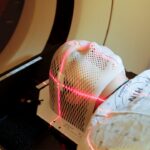When considering laser hair removal for facial hair, safety is a paramount concern. You may find comfort in knowing that this procedure has been extensively studied and is generally regarded as safe when performed by qualified professionals. The technology behind laser hair removal has evolved significantly over the years, leading to improved efficacy and reduced risks.
The lasers used are designed to target hair follicles specifically, minimizing damage to the surrounding skin. This precision is particularly important for facial areas, where the skin is often more sensitive and delicate. Moreover, many clinics utilize advanced cooling systems to protect your skin during the procedure.
These systems help to alleviate discomfort and reduce the risk of burns or other adverse effects. Before undergoing treatment, you will likely have a consultation where your skin type and hair color will be assessed. This evaluation is crucial because it helps determine the most suitable laser for your specific needs, ensuring a safer and more effective treatment experience.
Overall, when performed correctly, laser hair removal can be a safe and effective solution for unwanted facial hair.
Key Takeaways
- Laser hair removal for facial hair is generally safe when performed by a qualified and experienced provider.
- Potential risks and side effects of laser hair removal on the face may include redness, swelling, and skin irritation.
- It is important to choose a qualified and experienced provider for laser hair removal to minimize the risk of complications.
- Different types of laser hair removal devices for facial hair include diode, alexandrite, and Nd:YAG lasers, each with their own benefits and considerations.
- Before undergoing laser hair removal on the face, it is important to prepare by avoiding sun exposure and certain skincare products.
Potential Risks and Side Effects of Laser Hair Removal on the Face
While laser hair removal is generally safe, it is essential to be aware of potential risks and side effects associated with the procedure. You may experience temporary redness or swelling in the treated area, which typically subsides within a few hours to a couple of days. This reaction is similar to what you might experience after a mild sunburn and is usually not a cause for concern.
However, some individuals may experience more pronounced side effects, such as blistering or changes in skin pigmentation, particularly if they have darker skin tones or if the procedure is not performed correctly. Another risk to consider is the possibility of ingrown hairs, which can occur as hair follicles are disrupted during treatment. While this is not a common side effect, it can be uncomfortable and may require additional care.
It’s also worth noting that individuals with certain skin conditions or those who are pregnant may be advised against laser hair removal. Therefore, it’s crucial to discuss your medical history and any concerns with your provider during the initial consultation to ensure that you are a suitable candidate for the procedure.
The Importance of Choosing a Qualified and Experienced Provider

Selecting a qualified and experienced provider for your laser hair removal treatment is one of the most critical steps you can take to ensure a safe and effective experience. You should look for practitioners who are certified and have extensive training in laser technology. A skilled provider will not only understand how to operate the equipment safely but will also be knowledgeable about different skin types and hair characteristics, allowing them to tailor the treatment to your specific needs.
Additionally, an experienced provider will take the time to conduct a thorough consultation before the procedure. This includes discussing your medical history, explaining the process in detail, and addressing any concerns you may have. They should also provide you with realistic expectations regarding results and potential side effects.
By choosing someone with a solid reputation and positive reviews from previous clients, you can feel more confident in your decision and increase the likelihood of achieving satisfactory results.
Understanding the Different Types of Laser Hair Removal Devices for Facial Hair
| Device Type | Technology | Suitable Skin Types | Treatment Areas |
|---|---|---|---|
| Diode Laser | Diode technology | Fair to medium | Face, underarms, legs |
| Alexandrite Laser | Alexandrite crystal technology | Fair to olive | Face, legs, bikini area |
| ND:YAG Laser | ND:YAG technology | All skin types | Face, body, legs |
| Ruby Laser | Ruby crystal technology | Fair to light olive | Face, underarms, bikini area |
There are several types of laser devices used for hair removal, each with its unique features and benefits. You may encounter options such as Alexandrite lasers, Diode lasers, and Nd:YAG lasers during your search for treatment. Alexandrite lasers are known for their speed and effectiveness on lighter skin tones, making them a popular choice for many clients.
On the other hand, Diode lasers are versatile and can be used on various skin types, including darker complexions. Nd:YAG lasers are particularly effective for individuals with darker skin tones due to their longer wavelength, which penetrates deeper into the skin while minimizing surface damage. Understanding these differences can help you make an informed decision about which type of laser might be best suited for your facial hair removal needs.
Your provider should be able to explain these options in detail and recommend the most appropriate device based on your skin type and hair characteristics.
Preparing for Laser Hair Removal on the Face: What to Expect
Preparation for laser hair removal on your face involves several important steps that can enhance your overall experience. Before your appointment, you should avoid sun exposure and tanning products for at least two weeks. This precaution helps reduce the risk of complications during treatment.
Additionally, it’s advisable to refrain from waxing or plucking hair in the treatment area for several weeks prior to your session, as these methods can disrupt the hair growth cycle that lasers target. During your initial consultation, your provider will likely give you specific instructions tailored to your situation. You may be asked to shave the area being treated a day or two before your appointment to ensure that the laser can effectively target the hair follicles without interference from longer hair above the skin’s surface.
Arriving at your appointment with clean skin free from makeup or skincare products is also essential, as this allows for optimal laser penetration.
Post-Treatment Care and Recovery for Facial Laser Hair Removal

After undergoing laser hair removal on your face, proper post-treatment care is crucial for ensuring optimal results and minimizing side effects. You may notice some redness or swelling immediately following the procedure; this is normal and should subside within a few hours to a couple of days. To soothe any discomfort, applying a cool compress can be beneficial.
It’s essential to avoid sun exposure for at least two weeks after treatment, as your skin will be more sensitive during this time. Wearing sunscreen with a high SPF is highly recommended whenever you go outside.
Additionally, refrain from using harsh skincare products or engaging in activities that could irritate your skin, such as vigorous exercise or hot baths, for a few days post-treatment. Following these guidelines will help ensure that you achieve the best possible results from your laser hair removal experience.
Alternative Options for Facial Hair Removal
While laser hair removal is an effective long-term solution for unwanted facial hair, there are several alternative methods available that you might consider based on your preferences and needs. Traditional methods such as shaving, waxing, and threading are widely used but often require frequent maintenance. Shaving is quick and painless but may lead to stubble or irritation if done improperly.
Another option is electrolysis, which involves using an electric current to destroy individual hair follicles. This method is FDA-approved for permanent hair removal but can be time-consuming since each follicle must be treated separately.
Additionally, there are depilatory creams available that dissolve hair at the skin’s surface; however, these products can sometimes cause allergic reactions or irritation. Exploring these alternatives can help you determine which method aligns best with your lifestyle and desired outcomes.
The Long-Term Results and Benefits of Laser Hair Removal for Facial Hair
One of the most significant advantages of laser hair removal for facial hair is its long-term effectiveness. Many individuals experience a substantial reduction in hair growth after just a few sessions, leading to smoother skin and less frequent maintenance compared to traditional methods. Over time, you may find that any remaining hair becomes finer and lighter in color, making it less noticeable.
In addition to its effectiveness, laser hair removal offers convenience that many find appealing. Once you complete your treatment sessions, you can enjoy long-lasting results without the hassle of regular shaving or waxing appointments. This not only saves time but also reduces the risk of ingrown hairs and skin irritation associated with other methods.
Ultimately, investing in laser hair removal can lead to increased confidence and satisfaction with your appearance as you enjoy smoother skin without the burden of unwanted facial hair.
Laser hair removal is a popular method for achieving smooth, hair-free skin on the face. According to a recent article on InLaserHairRemoval, laser hair removal is not only effective for removing unwanted facial hair but also offers long-lasting results. The article discusses the benefits of laser hair removal for the face, including reduced risk of ingrown hairs and irritation compared to traditional hair removal methods. If you are interested in learning more about how laser hair removal can benefit your face, check out the article on InLaserHairRemoval.
FAQs
What is laser hair removal for the face?
Laser hair removal for the face is a cosmetic procedure that uses concentrated beams of light to remove unwanted facial hair. The laser targets the pigment in the hair follicles, damaging them and inhibiting future hair growth.
Is laser hair removal safe for the face?
When performed by a qualified and experienced professional, laser hair removal for the face is generally considered safe. However, there may be some risks and potential side effects, such as skin irritation, redness, and changes in skin pigmentation.
How effective is laser hair removal for the face?
Laser hair removal for the face can be highly effective in reducing and removing unwanted facial hair. However, multiple sessions are usually required to achieve long-lasting results, as the treatment is most effective on hair in the active growth phase.
Are there any limitations to laser hair removal for the face?
Laser hair removal may not be suitable for everyone, especially individuals with certain skin tones or hair colors. It is important to consult with a qualified professional to determine if laser hair removal is a suitable option for your specific skin and hair type.
What should I expect during a laser hair removal treatment for the face?
During a laser hair removal treatment for the face, a handheld device will be used to deliver the laser energy to the targeted areas. Patients may experience a mild stinging or snapping sensation during the procedure, but most find it tolerable. The duration of the treatment will depend on the size of the area being treated.
How should I prepare for a laser hair removal treatment for the face?
Prior to a laser hair removal treatment for the face, it is important to avoid sun exposure and tanning beds, as well as certain hair removal methods such as plucking or waxing. It is also recommended to shave the treatment area prior to the appointment.
What is the recovery process like after a laser hair removal treatment for the face?
After a laser hair removal treatment for the face, patients may experience some redness and mild swelling, which typically subsides within a few hours to a few days. It is important to follow post-treatment care instructions provided by the professional to ensure proper healing.




